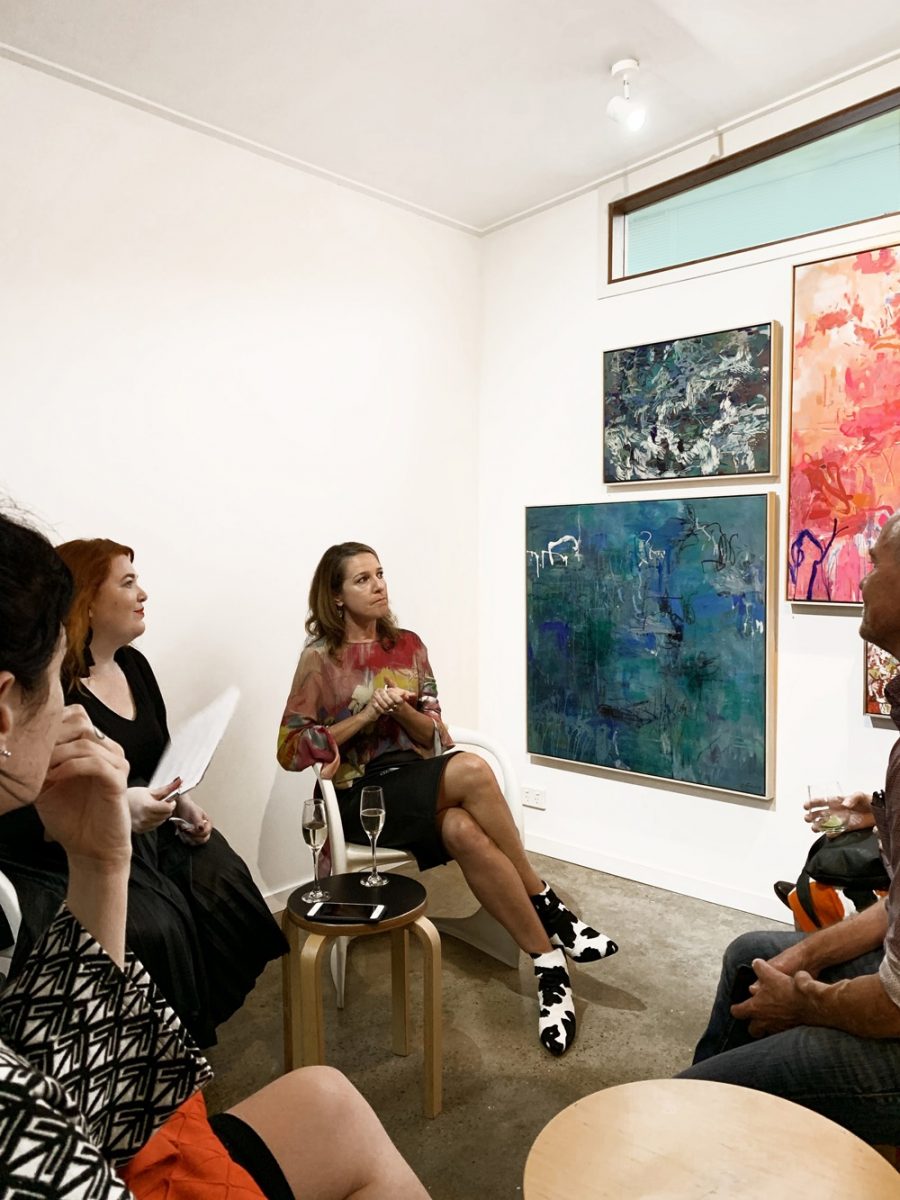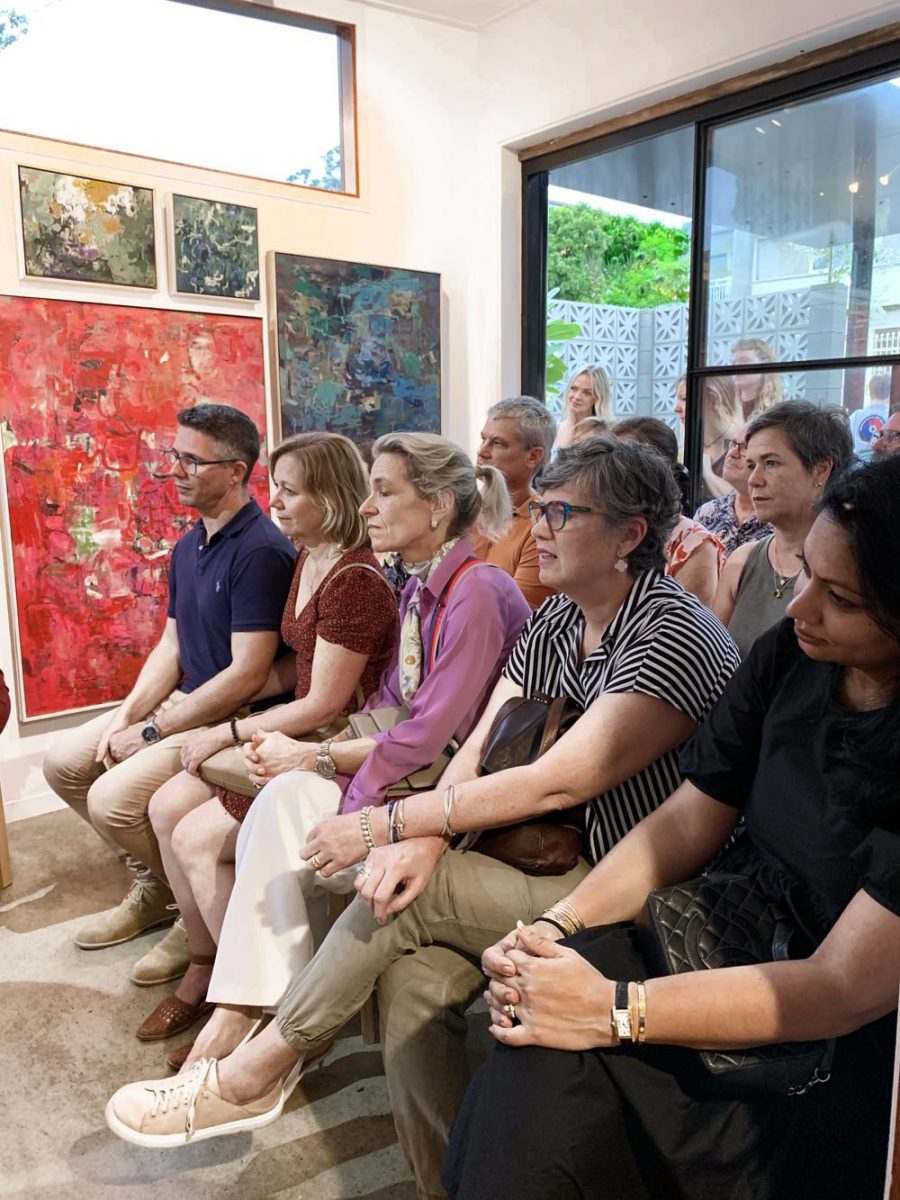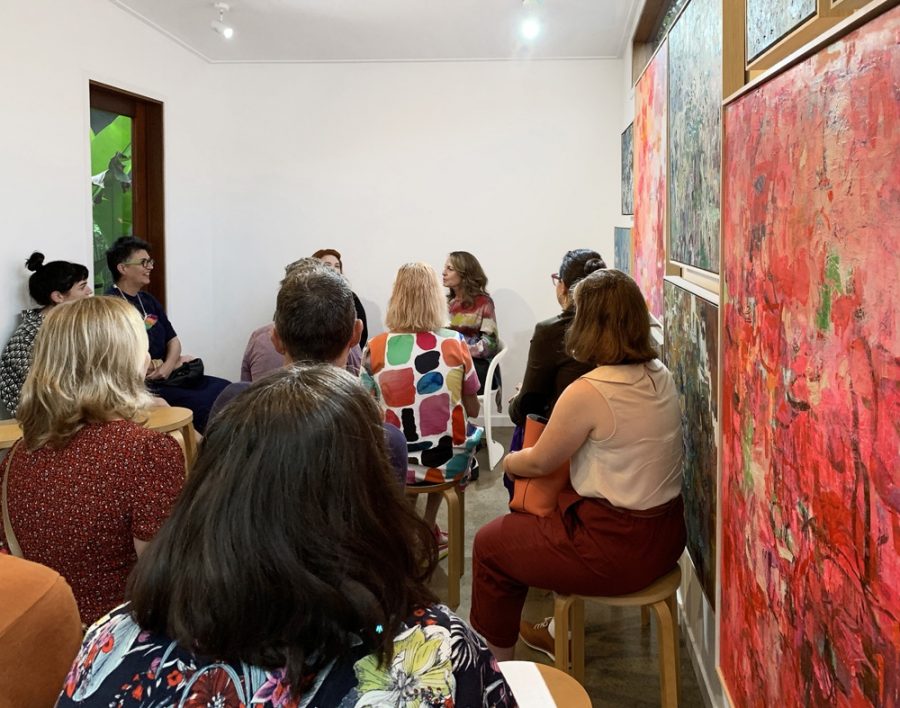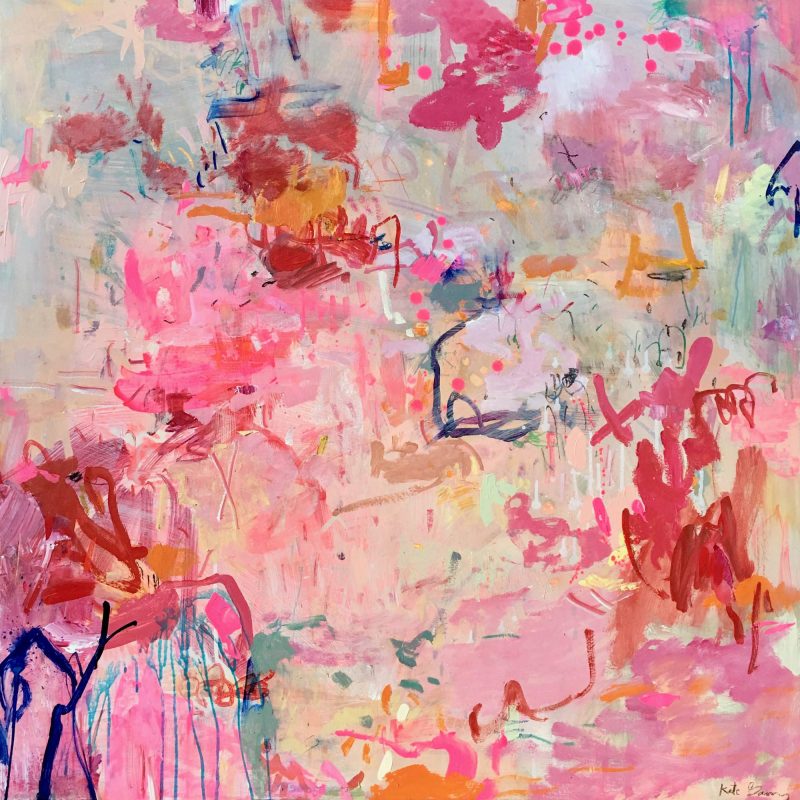Laura: Ok! We can get started now. Thank you so much to all of you for braving the crazy weather and making your way over to our little space. It means the world to us, so thank you for coming by to be part of the discussion with Kate and I. SOURCE has officially opened tonight, yay! (audience applauds) and I’m extremely excited to welcome Kate to Side Gallery! I’m also excited because obviously this is all completely new work.
Kate: Yes!
Laura: And probably a bit different to what the audience is used to seeing from a Kate Barry exhibition. Also, the hang is different for us; we’ve loved doing something a little different for this exhibition and I’ll come back to that a little later in the discussion, too. So I guess we’ll jump right in. First of all, I’d like to start off with asking if anyone has any questions? Sometimes that’s a good way to direct the conversation.
Audience member: Yes, I’ve got a question; Kate what is your process like? I’d love to know if you have a vision when you start of how you want the finished piece to look like, or even a notion of the direction for the final piece?
Kate: Yes, I mean they really paint themselves, but often I start with a colour process in mind. All of my paintings come from instinct, or I try and delve up or deep into emotions, nostalgia, memories… every emotion has a colour for me and I like the way colours can sort of bang together or leave a touch of awkwardness, or settle nicely together. So, the colour is the first thing I start with, then as I go on… well you might know I stand around my work, it’s very physical so every mark, or line, or stroke has a different thickness which relates. It’s a real memory experience. I try to keep it really painterly, abstract, and do “loose paint” handling and that is very spontaneous. So often my hardest thing is knowing when to stop. Or settle. I keep coming back and there’s always something to change, adapt, the painting keeps giving. I stop and I let them rest, move them downstairs and twist them around. There’s always a touch of awkwardness, too which I think is the hook for each piece. Something a little unexpected in each.
Laura: I think you’ll find too, for those of you who like art history nerdiness, we can find that these reasons are perhaps an indicator of where Kate’s work sits within abstraction- there is sometimes these strong themes of nostalgia, and even narrative underneath the brushwork. Which is often devoid in what we consider abstract art so I think that only recently, I had wanted to nail down what I thought of Kate’s work in a curatorial sense, and did a lot of research and was directed to this term, “lyrical abstractionism” by another curator. I think the word lyrical really helped me to understand what we see, and what we understand when we look at Kate’s work. When we use the term lyrical you can see the brushstrokes representing that, or see that Kate really relates to it-
Kate: Yeah, that’s right. I’ve often described my work that way without knowing much about that, I’ve always thought of it as lyrical. I often see the lines or brushwork on the top layers as a kind of language or a written word, like an energy that is buzzing on the surface.
Laura: Which historically is linked to composition, and makes it sit there within the sub-genre of abstractionism really beautifully. We as viewers can so easily get the sense of nostalgia, mystery, memory from these works, and the depths of what it is you’re using to create them, because of that.
Kate: Yeah, and often it's with a fervour or force, it just depends, and sometimes it comes down to the fragility of the marks. And yeah, I think that the whole lyrical abstraction has really forced me to look at that, and yes, nailed it.
Kate: Every artwork encompasses doubts, you know, or frustration, inspiration, enthusiasm. You can go through the motions. I know it can sound a bit deep but I run to keep my body fit, and I paint to keep my spirit fit. I’m not from Brisbane so a lot of it draws from home, from memories of childhood and Christchurch, and what ties me to the colours and the land of NZ, the colours of childhood and the memories of that. I don’t go anywhere else (all laugh), so it really is about those memories for me and a busy home life. They’ve never been calm, still, figurative works.
Laura: So how do you think this show came together? With the new works, new gallery, etc.
Kate: I’m really proud of this show. As a lot of you would know, I’ve been a graphic designer for 25 years which presents a set of challenges, like working to other people’s rules, or a brief. It was very subjective so now I just tend to do what I want. I wasn’t really thinking about this too much. I got used to using a smaller brush, a lot of my work uses large gestures and I thought about this space and while its not really a huge space, I thought I would scale down as it’s not really conducive to hanging really large works.

Audience member: So when would you have started this process, of making this works or conceptualising for this show?
Kate: Ummm, maybe after November, December. I work from home and this wasn’t a chore, we didn’t go away, so I just made across that entire period. I can paint in my underwear if I like… well actually I can’t anymore because my neighbours renovated. But I often have a few going at once, and people here would know, there are often more than 1 title on the back so I am always working on these other ideas. I often rework them or twist them up the other way, even after they are framed (all laugh) because that gives them a hint of awkwardness, and that is what I like about them. Another way of seeing. My biggest frustration is that my studio is quite small. So I take them downstairs and sit with them for a while, amongst the washing on the couch. So to answer your question, they are all quite recent, and haven’t been shown anywhere else. None of these, and certainly not the small one’s, as they were Laura’s initiative.
Audience member: So do you start with a block colour?
Kate: A few block colours, yeah. When I say there is acrylic and oil, there isn’t oil over the top of acrylic, but more like smears of colours, maybe four (?) colours. There’s no method, no 1, put this layer on, then put the next layer on.
A lot of these have almost just as much taken off as there is put on, with a sander or… everyone in my house is frustrated because there are no spatulas or bbq tools let in the kitchen, and all the knives have blunt tips.
I strive for that loose kind of graffiti look, rather than sometimes just being pretty.
Laura: Well that leads us to the next part, the small works, and how large scale, particularly within the history of abstract art, scale plays a large part in that because it is often very easy to use large, gestural motions with a large canvas or board. Tell me how you went when I suggested trying to use small, restricted sizes and gestures to create the small works?
Kate: I was excited! I thought initially that they would be smaller areas of cropped large works. They didn’t work out like that, it was more like a stream of consciousness. I just blitzed it, I was so into it and it was so enjoyable. Scaled down the tools, shifted my workspace to the kitchen table, got a lot more crayon and pencil and pen, and I said to Kitty (Horton) that, “I just want to make scribbly artworks!” And she said, “then make scribbly artworks!” So I thought of you, Kitty (all laugh).
And anyway they just flowed out, I really enjoyed them because I used to do that sort of thing in my early 20s. I said before, they started out as a colour idea, and some of them have a shine or varnish on them because I wanted them to have a bit of that on there. I never think about what’s going to sell, what’s in fashion etc. Then again, I do like fashion so maybe subliminally… Stella (Danalis) and I have talked about this, too. You just kind of subconsciously pick up fads or colour palettes. I think it's an artist thing.
Audience member: Maybe it could be the scale has actually released you from that feeling of preciousness that a large work immediately sets up. Takes away that barrier etc.
Kate: You’re right, you’ve got that. I didn’t have that with the little ones. It was so liberating and I’d like to do more of them.
Laura: They’ve been so popular. So many enquiries and some have sold already, still an hour out from opening night! Which is always a great sign when an artist makes new work that is perhaps a slight deviation from what they usually present. The small works have done just that, and it’s obviously a higher production, so many are produced. I think that more come out and it's interesting to see how many people are drawn to small scale.
Kate: I’ve been surprised, too! I never really thought people would want to see the smaller ones-
Laura: Well everyone loves a large, statement piece in their house. But perhaps this allows them to have a small breath, or a small rest of a space and put one of these works there.
Kate: Totally!

Laura: Well I guess the next thing we should do is discuss the hang!
Kate: Well, that’s, yeah…such a good hang. Ingenious! (all laugh)
Laura: oh, go on… no really (all laugh)
Laura: Obviously this is (gestures toward exhibition) something that I thought a lot about. There’s a lot of blank space in here, and for such a small gallery obviously its intentional (laughs) otherwise you end up with work everywhere and no real reason for it other then it fit there.
How did you go with letting someone else do the entire hang for you, and let’s discuss whether we think it was successful for your work or not?
Kate: Oh, my gosh. Look, I’m an artist. All I want from other people is trust. And as a designer I used to just want trust, you know, I didn’t want an editor saying, “oh no, we don’t like yellow… we’re not doing yellow” or “we’re not having a sans serif typeface… For God’s sake, you know what you’re talking about and I loved the idea that it is intentional, and intense. It is a reflection of how I create my work…with intensity.
Laura: For those of you who are new to Side Gallery, and the idea of having a curator as part of the exhibition process, for us it is the framework that Kate will bring her ideas and work to the space, and while choosing and following a theme that runs through the body of work, I look at exhibition and design of the space as part of my job and really decide how we’ll best present the work to an adoring audience (all laugh). For me, there was an intensity and an emotion that has been suspended in the works, across the canvas or board. I really liked the idea of putting that into the audience’s face a little more. The traditional way to hang abstract art has primarily been to give it a lot of room, let the pieces rest, and let the audience feel comfortable while viewing it. Not always, but predominantly. Pushing the works close together, with super small margins between them, going above and below our natural eye level… I do think the intention was to make the audience maybe get a sense of that intensity, consider the works hurriedly and be dragged along the wall piece by piece. We’ll see if everyone thinks that has been successful or not, but that was the hypothesis (all laugh). It was great that Kate was so open to that, because even on the day we did it, there was still that lingering question of, “should we?”.
Kate: No I was so pleased, I love the fact that it was a cluster of intent, of intense emotion. You can go away, rest your eyes, have a breather, and come back and see something entirely different. With my artwork there’s always something else to see. So you come back and it almost forces you to look at it all again, and differently.
Laura: As an audience member, that’s what I find. I do like to return to a work multiple times to get the entire spectrum of intent in a work. To see the details, and not always miss something because I’m chatting at an opening, like usual.
Kate: I like the way that Laura and Leesa have decided to hang the show like that; it’s edgy and a point of difference, a bit different and nice (Kath and Kim voice). And of course, a touch of awkward.
Laura: So tonight as you’re enjoying the works and the lovely wine and cheese, I invite you all to consider if it’s worked! (all laugh).
Kate: Thank you so much to everyone for coming, I really do appreciate the support. And to Laura and Leesa. It’s been amazing. Thank you to John and Stella. They are going out of their way to pick up work, and drop it off, and it’s been incredible. (applause)
Laura: Thanks everyone!




